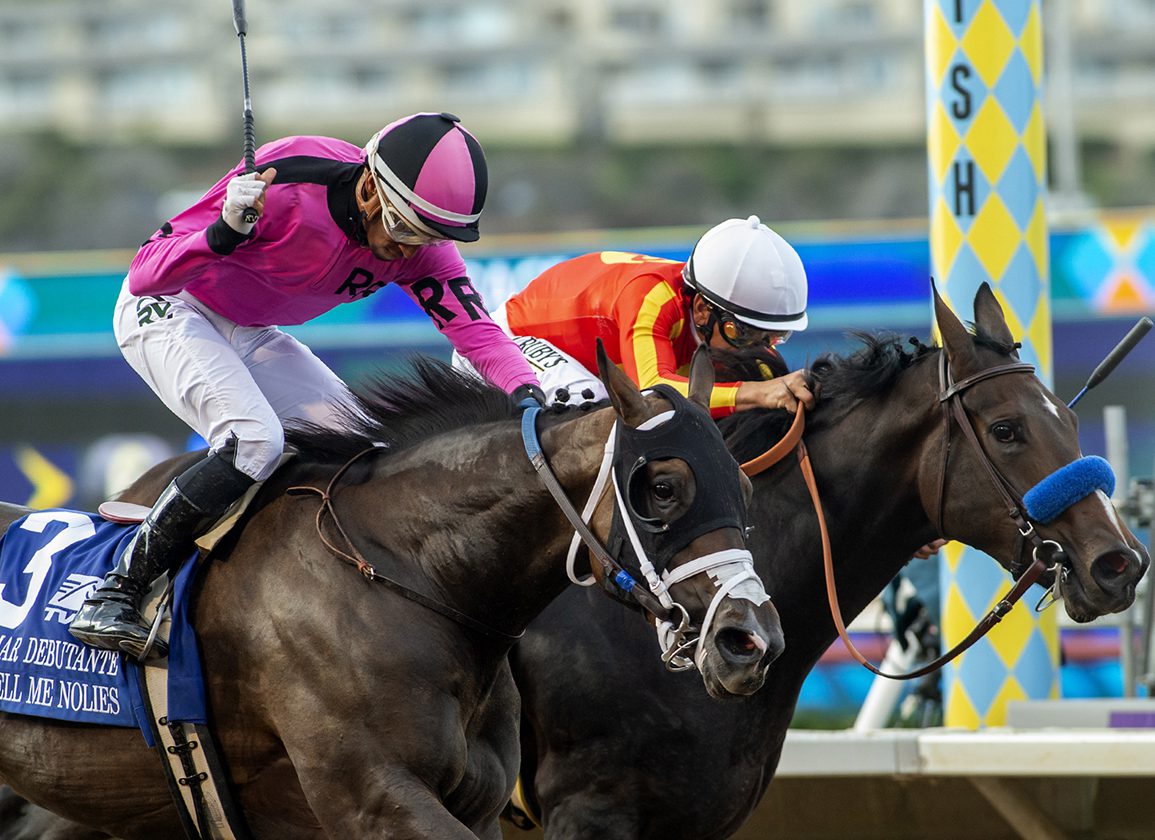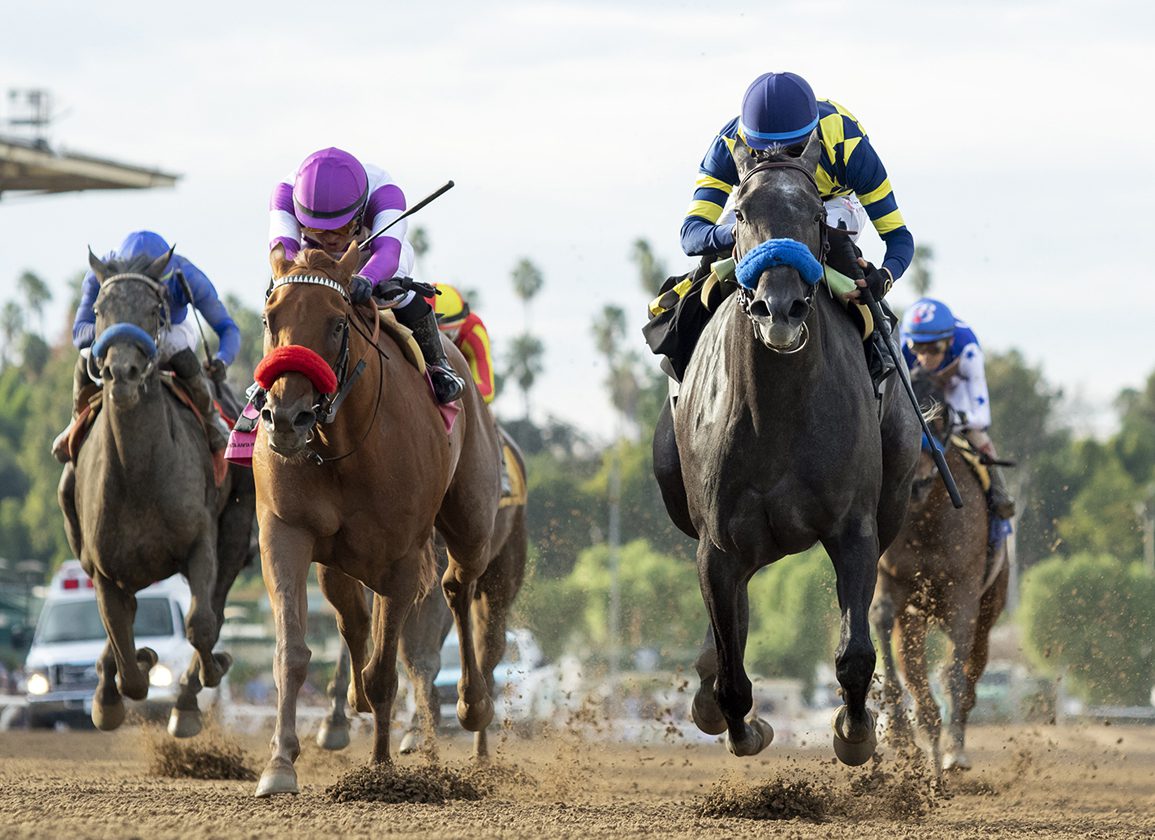With his third and final crop wrapping up their juvenile season, Arrogate has a narrow window remaining to make his mark as a sire, and yet his legacy is far from being fully written as his offspring now begin their careers as producers.
Arrogate, the son of Unbridled's Song who delivered one jaw-dropping performance after another on the racetrack, began his stud career at Juddmonte with seemingly limitless potential until he suddenly and tragically passed away the summer before his first crop sold as yearlings. Since then his progeny have succeeded at the highest level and Arrogate is now responsible for more Grade I winners than any other third-crop sire aside from Gun Runner.
Among his five Grade I winners, three daughters of Arrogate will begin the next chapters of their careers this week as And Tell Me Nolies, Fun to Dream and Secret Oath go through the ring at the Fasig-Tipton November Sale.
“Arrogate was honestly one of the most talented racehorses I think any of us have witnessed,” reflected Fasig-Tipton's Boyd Browning. “The name Juddmonte is synonymous with the highest caliber and Arrogate certainly achieved that as a racehorse. He has clearly passed that on to his offspring with their desire to win and to compete. When you look at the success that he's had at the highest levels, it's pretty remarkable. We all mourn his loss because I think we're going to see that we had an opportunity to witness another great stallion in the making, but his influence will continue on through these outstanding daughters as well.”
The first to claim Grade I status for her sire, Secret Oath won an unforgettable edition of the Kentucky Oaks when she handed legendary conditioner D. Wayne Lukas his fifth Oaks win in her two-length score over a field that featured champions Nest (Curlin) and Echo Zulu (Gun Runner).
Secret Oath's career was nothing short of a fairytale story for her owners and breeders, Robert and Stacy Mitchell of Briland Farm. Out of their stakes-winning, Grade I-placed homebred Absinthe Minded (Quiet American), Secret Oath was a winner at two and her 3-year-old season included two standout performances against males with a third-place finish in the GI Arkansas Derby and a fourth-place effort in the GI Preakness S. She also claimed the GIII Honeybee S. by seven and a half lengths and was second to Nest in both the GI Coaching Club American Oaks and GI Alabama S.
This year at four, Secret Oath scored in the GII Azeri S., defeating MGISW Clairiere (Curlin), and was runner-up in three more Grade I contests. She placed in 14 of her 18 career starts and earned over $2.4 million.
“She was a picture of consistency,” Lukas said upon her retirement in October. “She showed up every time. Whenever I ran her she was right there. Secret Oath was good every time we started her. She always hit the board.”
And Tell Me Nolies was the first to prove Arrogate's ability to produce a top-level juvenile with her victory in the 2022 GI Del Mar Debutante, but the next day Cave Rock followed her effort up with a win in the GI Del Mar Futurity. A month later, the pair claimed headlines on the same day as Cave Rock got his third straight win in the GI American Pharoah and And Tell Me Nolies stumbled at the start but rallied to win the GII Chandelier.
A $230,000 2-year-old purchase out of a Grade III-winning half-sister to GISW Macho Again (Macho Uno), And Tell Me Nolies went on to claim two runner-up efforts behind Faiza (Girvin) this year in the GIII Santa Ysabel S. and GII Santa Anita Oaks and later run third in her turf debut in the GII San Clemente S.
Arrogate's third Grade I-winning daughter Fun to Dream was a debut winner at three and she followed that effort with a near 10-length victory in the Fleet Treat S. Trained and co-bred by Bob Baffert, the Cal-bred filly boasted a near perfect five-for-six record as a sophomore when she concluded the year with a win in the GI La Brea S. This year at four, Fun to Dream claimed the GII Santa Monica S. and lost by a narrow head to A Mo Reay (Uncle Mo) in the GI Beholder Mile S.
Arrogate's influence continued to grow this year with the achievements of Arcangelo, winner of the GI Belmont S. and GI Travers S. Withdrawn from the Breeders' Cup Classic due to a foot issue, Arcangelo will be the first son of Arrogate to go to stud as he retires to Lane's End Farm.
Although dual Grade I winner and Breeders' Cup Juvenile runner-up Cave Rock sadly died of laminitis, Arrogate could perhaps have another potential heir from his final crop in Liberal Arts, winner of the GIII Street Sense S. on Oct. 29.
“It's a continuation of a sire line that has been a really important influence in North American racing over the last 25 years in Unbridled's Song,” said Browning. “Arrogate is out of a Distorted Humor mare, so you've got really some of the 'who's who' of North America racing assembled in terms of a pedigree perspective and they've achieved the success on the racetrack.”
A fourth graded stakes winner by Arrogate will be offered at Fasig-Tipton on Nov. 7. Campaigned by AMO Racing and trained by Graham Motion, Affirmative Lady, who is out of stakes winner Stiffed (Stephen Got Even), was a contender on the Kentucky Oaks trail as she ran second to Julia Shining (Curlin) in the GII Demoiselle S. at two and this year claimed the GII Gulfstream Park Oaks, defeating GISP Sacred Wish (Not This Time).
“We've now got four daughters that are of the highest level of success and I think it gives people the opportunity to have a piece of history and continue the legacy of Arrogate as he makes his mark for future generations.”
The post Arrogate’s Grade I-Winning Daughters on Display at Fasig-Tipton appeared first on TDN | Thoroughbred Daily News | Horse Racing News, Results and Video | Thoroughbred Breeding and Auctions.


